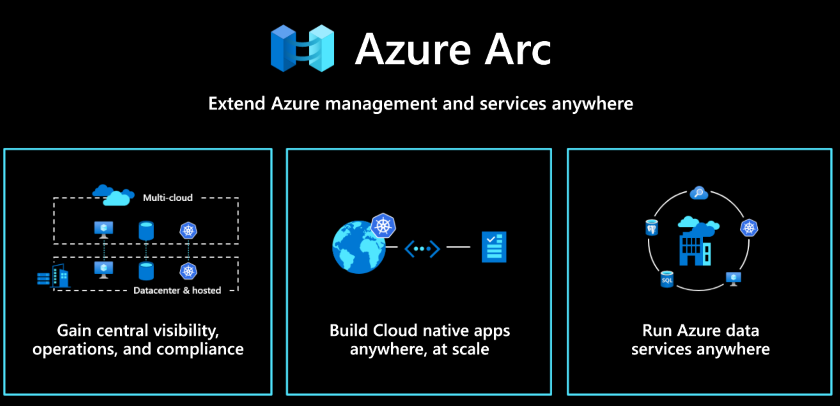Microsoft Azure Arc can help you manage Windows Server instances, Linux instances, Kubernetes clusters, and connected data sources!

Thinking about going hybrid – Where to start?
The biggest challenge I see amongst customers is to answer two important questions. First, how they will manage on-premises workloads. Second, how they will align on-premises environment to the cloud management style.
To manage this challenge, here is a basic strategy for cloud adoption. I will elaborate on that later in this article.
- Identify the existing environment that you want to be Arc enabled. Make sure you get that connected (simple deployment, agent based).
- Determine which capabilities to add. You can start with the ARM Control plane, but also with the security capabilities, like Microsoft Defender for Cloud.
- Make use of Arc enabled services.
So, what is hybrid, multi-cloud and edge?
Hybrid is needed when you have an environment that you need to run anywhere. You need visibility into that environment anywhere. Hybrid is the work that you do in the edge and in the cloud.
So, what is edge? Disconnected manufacturing floors, IoT smart devices. They all need common security, common governance, portability between the edge and the cloud. IT teams need one dashboard: a perfect view how IT operates, and how everything operates.
When to consider Hybrid solutions?
One of the most well-known reasons for opting into the hybrid cloud is network latency. For example, manufacturers may use edge computing for applications that control and coordinate heavy machinery. Having high network latency or a spike in latency in such environment can cost a lot of money or even worse lives. However, they can prevent these events from happening with the use of cloud computing. By saving and processing analytics data on the cloud, manufacturers can predict when maintenance will be needed.
Another well-known case for hybrid computing is security and compliancy with governmental legislation. Some governments require you to save and process sensitive data only in certain countries or regions. This is where edge computing is a good fit, and the company may use the cloud for processing and saving all other data.
App modernization is another key driver. The pandemic has changed and pushed how fast we modernize the apps. We all had to make sure that the apps were able to perform for the home-workers. That moment, developers had the ability to also modernize the app and place it in the cloud in one step. As a result, the pandemic helped and fastened the app modernization, even to a hybrid or multi-cloud environment. The control plane of Arc gives you the same practices as in Azure. We see that Kubernetes is growing, and Arc enabled Kubernetes environments will grow also.
A mostly overlooked case for hybrid computing is the cost of bandwidth. In most clouds, like Azure, importing data is free of charge. Exporting data out of the cloud will cost for most businesses just a fraction of the total cloud expense as it only costs a few cents per GB.
Benefits of Azure Arc: consistency across the different environments
In a cloud versus a hybrid world, there are some nuances. As mentioned in the above examples, in a hybrid solution, there is always existing stuff that exists on-premises and cannot be moved. Or that they are not going to take the time to migrate to the cloud. Hybrid is here to stay! That’s why, there is a need for consistency across the different environments. In a hybrid solution they can connect back to the cloud and use the control plane and cloud practices.
A single control plane
Azure Arc gives you the governance control, via a control plane. That gives you the common view and a single way to do it. Additionally, Azure Arc also provides you with the ability to run Azure services anywhere and start to leverage the portability of Kubernetes. In that way it starts to allow the IT end-developers to start to leverage the same skills and same technology everywhere.
Push governance to on-premises
However, hybrid is much larger than the single pane. The ARM Control plane is designed for hybrid, from the beginning: inventory, governance, configuration management, policy aspects, security. This enables push governance down into on-premises.
- For example, if you are using Office365 for your mail, it’s also covered by rules and regulations. When there will be an auditor to check the environment, you will pass because of those governance rules that already exist. That will be the same when you start using the Governance practices from the cloud into you on-premises environment.
- Another example, a simple (real-time) inventory can be run if you are using the cloud to govern your on-premises environment. Not an outdated CMDB application that is not updated for the last couple of months. You can use Resource Graph to query the Azure resources and on-premises resources. You can use the same Azure Policies for your cloud resources and what is on-premises as well.
Scalability
Finally, another important benefit of hybrid solutions is scalability. When computing and processing demand increases beyond an on-premises datacenter’s capabilities, businesses can use the cloud to instantly scale capacity up or down to handle excess capacity. Moreover, it allows them to avoid the time and cost of purchasing, installing, and maintaining new servers that they may not always need.
The building blocks of a hyrbid cloud solution with Azure Arc and Azure Stack HCI
With a hybrid solution on Azure you can extend compute and AI to the edge.
There are different elements of Azure you can build from:
-
Azure Arc: manage and govern with a single control plane.
-
Azure Stack HCI: modernise on-premises infrastructure. Azure Stack is a flexible HCI delivered as an Azure hybrid service. It is a hyperconverged infrastructure (HCI) operating system delivered as an Azure service that provides the latest security, performance, and feature updates. Deploy and run Windows and Linux virtual machines (VMs) in your datacenter or at the edge using your existing tools, processes, and skill sets. Extend your datacenter to the cloud with Azure Backup, Azure Monitor, and Azure Security Center.
-
Azure Arc enabled servers: manage Windows and Linux physical servers and virtual machines hosted outside of Azure, on a corporate network, or other cloud provider.
-
Azure Arc enabled data services: bring Azure services anywhere.
-
Azure Arc enabled for Kubernetes: attach and configure Kubernetes clusters located either inside or outside Azure.
Azure Arc: How the building blocks come together in your strategy
If you think about Arc enabled, the first layer you have is the control plane. That is your governance, your visibility, your central view across, to manage all the resources in the same way in the Azure Portal, API layer or Command line interface layer.
The second is Arc Enabled servers or Kubernetes environments.
Then you have the Arc Enabled services. These are the new Azure services that can run anywhere in a Kubernetes environment. Can be off Azure. This means that you can take a SQL Database and put it into your on-premises environment.
Azure Arc enabled Kubernetes
Kubernetes is coming to be an enabler to lift these Azure Services into a different platform. IT is moved to a cloud center of excellence, where we are seeing a lot of governance and security capabilities. It enables the acceleration for controls and safeguards for developers.
Kubernetes is growing immensely. Not only because of the open-source community around it, but also because of the wide adaption of containerized applications. Kubernetes and Arc integration is a key differentiator for Microsoft in comparing to other clouds. You can ensure portability, if you need to be able to move or have different environments that need to be consistent. With Arc enabled services you have the flexibility at the Kubernetes level, it is not required to have a specific distro designed by Microsoft. As long as the distro is CNCF certified, it is good to go! Governance and management tools in the Kubernetes space are the same.
The developers are modernizing and leveraging the cloud even more, they are betting on Kubernetes. Modern apps are built on Kubernetes and they leverage the capabilities of the cloud even more. They leverage the management capabilities to streamline that process even more and consistently. The app and the developer have advantages: they can build on Azure and use Azure Services, but are in control if they need to move the app back to on-prem for regulatory, or data sovereignty.
We all have a desire to leverage the cloud more. To support that, Microsoft has enabled both sides (on-premises and cloud). As a result, these days you cannot even tell on which end the app is, with Azure Arc!
Azure Arc Data Services
Arc enabled data services, really gives you the capabilities like you have in Azure. Keeping your services up-to-date, performance recommendations, tuning capabilities.
That is the goal of Azure Arc enabled Data services or Azure Functions, Logic Apps, and ML services.
Keep learning around Hybrid Management with Azure Arc!
Be sure to follow along with the upcomming articles for Azure Arc!



